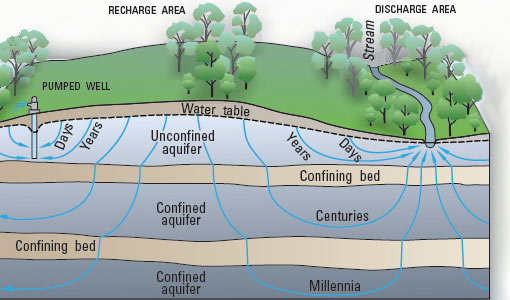
by Bill Schlesinger
Deep underfoot in most regions of the world is a zone where the fractures in bedrock are filled with water—known as groundwater–constituting the water table. Globally, the amount of water in this zone, known as the phreatic zone, is poorly known, but most certainly exceeds that in all the rivers and lakes on the surface of Earth.
Groundwater derives from the slow downward seepage of water from precipitation, that escapes evaporation, transpiration and surface runoff. The amount of groundwater divided by its estimated rate of recharge is known as its mean residence time, which varies between 690 and 1000 years. This value belies the dynamics of groundwater, which consists of a small pool that turns over rapidly and a much larger proportion that turns over slowly—with a mean residence time of 12,000 years. In much of the desert Southwest, the groundwater derives from recharge during the last glacial period, when that region was much wetter than today. Hydrologists can estimate the age of groundwater by measurement of the radiocarbon age of the carbon dioxide dissolved in it.
Groundwater is widely exploited. Our house in Maine is supplied by a 160-foot well tapped into the local groundwater. Vast areas of cropland in the High Plains of Texas, Kansas and Nebraska are supplied by groundwater used for pivot irrigation. And, agriculture in the Central Valley of California is largely dependent on groundwater extraction.
In areas of heavy use, the depth to groundwater has increased. Some recent measurements in California suggest that the decline in groundwater has averaged about 20 mm/year. Again, regional differences are of note. Agriculture in West Texas, supplied by the Ogallala aquifer is expected to deplete that groundwater reservoir by the end of the century. Here, groundwater levels are declining as much as 1000 mm/yr, and natural recharge of the aquifer would require 10,000 years to restore the lost volume.
A recent paper by Scott Jasechko and his colleagues surveyed more than 170,000 monitoring wells worldwide, finding declines in groundwater exceeding 500 mm/year in many dry-land areas used for agriculture. In many areas groundwater decline appears to be accelerating, but in some regions changes in water management have allowed depleted aquifers to recover. Reversal of groundwater losses will be essential for continued agricultural production to feed the rising human population. We may not see groundwater, but it must be carefully managed if we expect its use to be sustainable.
References:
Doll, P. and K. Fiedler. 2008. Global-scale modeling of groundwater recharge. Hydrology and E rth System Sciences 12: 863-885.
Famiglietti, J.S., M. Lo, S.L. Ho, J. Bethune, K.J. Anderson, T.H. Syed, S.C. Swenson, C.R. de Linage and M. Rodell. 2011. Satellite measure recent rates of groundwater depletion in California’s Central Valley. Geophysical Research Letters 38:
Fan, Y., H. Li and G. Miguez-Macho. 2013. Global patterns of groundwater table depth. Science 339: 940-943.
Gleeseon, T., K.M. Befus, S. Jasechko, E. Luijendijk and M. Bayani Cardenas. 2015. The global volume and distribution of modern groundwater. Nature GeoScience doi: 10.1038/ngeo2590
Jasechko, S. 2019. Global isotope hydrogeology—review. Rev. Geophysics 57:835-965.
Jasechko, S., H. Seybold, D. Perrone, Y. Fan, M. Shamsudduha, R.G. Taylor, O. Fallatah and J.W.Kirchner. 2024. Rapid groundwater decline and some cases of recovery in aquifers globally. Nature 625: 715-721.
Scanlon, B. R. et al. 2012. Groundwater depletion and sustainability of irrigation in the US High Plains and Central Valley. Proceedings of the National Academy of Sciences US. 109: 9320-9325.